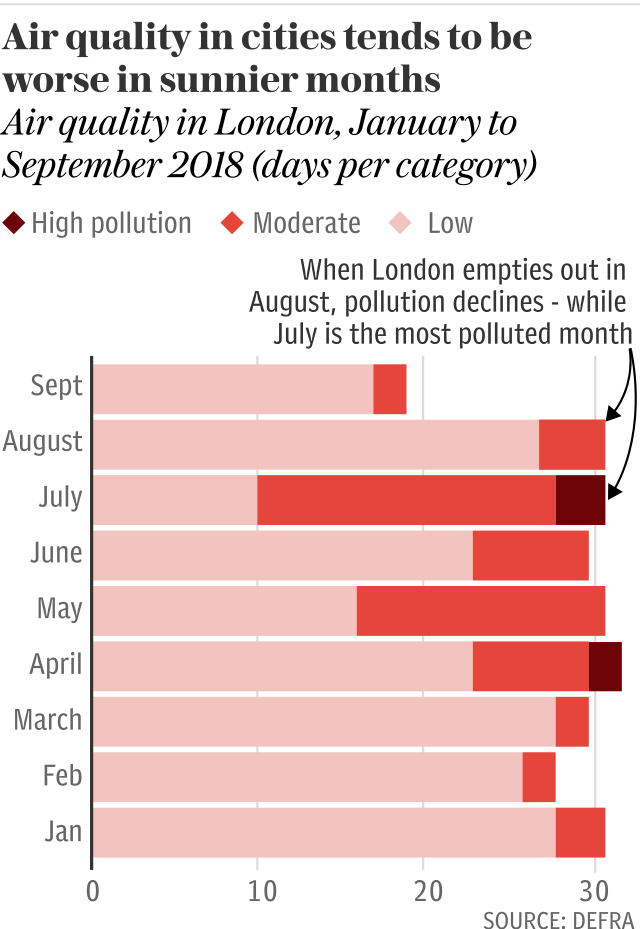The cleanest and most polluted air in the UK revealed: how clean is it where you live?

Air pollution is one of the most pressing public health issues facing the UK, with new health warnings hitting the headlines on a seemingly weekly basis.
It can, however, be pretty tricky to avoid breathing polluted air - especially if you live in London, where pollution levels were worse than Beijing for brief periods last year.
But it is not just people living in the capital who should be concerned about the quality of the air they breathe. Pollution is rife across the southern half of Britain, particularly in the Midlands and near major main roads.
We analysed figures from DEFRA to see where the cleanliest and dirtiest air in the UK can be found, and you can see how your area fares using the interactive map below.
Does the square kilometer around your house exceed the annual limit for particulate matter recommended by the World Health Organisation (WHO)? What about near your child's school?
The cleanest and dirtiest air in the UK
Every year DEFRA produces a model estimating the air pollution levels for every square kilometer of the UK. The latest estimates - based on 2016 figures - show that around 14,500km2 of the country has annual levels of small particulate matter (PM2.5) exceeding the 10 μg/m3 recommended by the WHO.
The cleanest land-based part of the country is - as you may have guessed - on top of a mountain in the Scottish Highlands.
Located between Inverness and Ullapool, the area to the south west of the summit of Sgùrr Mòr (the highest of the Fannich mountains) has an annual average of 2.936 μg/m3 for PM2.5.
At the other end of the scale the most polluted square kilometer of the country isn't in London, but in Solihull in the West Midlands.
Situated immediately to the west of the Jaguar-Land Rover factory and close to Birmingham Airport, the area encompassing Lode Lane, Hobs Moat Road and Castle Lane was the only part of the UK with an annual average above 15 μg/m3 for PM2.5.
The dangers of particulate matter
There are many types of air pollution which are hazardous to human health but particulate matter (PM) has become the shorthand for measuring pollution levels.
PM particles, which are classed as a carcinogenic, are small in diameter, which means they can penetrate deep inside people's lungs and even enter the blood system. The smaller PM particles, the most concerning for human health.
Nitrogen dioxide (NO2) is the other pollutant most discussed, and is caused by vehicle fumes and heavy industry. NO2 levels tend to be highest in cities and near main roads.

In the last couple of months alone, research has linked unclean air to conditions ranging from diabetes to dementia.
According to the World Health Organization, poor quality air is a greater global threat than diseases such as Ebola and HIV, with seven million pollution-related deaths globally each year.
Statistical modelling from the Royal College of Physicians estimates that around 40,000 lives are shortened in the UK due to air pollution. The burden is, unsurprisingly, highest in major urban areas.
The 21 local authorities with the highest proportion of deaths attributable to air pollution are all in London, according to Public Health England research from 2010. In both Westminster and Kensington and Chelsea, over eight per cent of deaths were linked to unclean air.
The Birmingham suburb of Sandwell, along with the Berkshire town of Slough, topped the list of deaths attributable to air pollution outside England's capital city.
The further north you go, the cleaner the air
So far in 2018, the South East of England has had the most days (70) with high or moderate air pollution, according to the Daily Air Quality Index.
Closely following was the South West with 68, and Greater London with 64. In contrast, North East Scotland has seen just 3 moderately or highly polluted days so far this year.
What does this mean? According to government recommendations, children and adults with lung and heart problems should "consider reducing strenuous physical activity, particularly outdoors" when pollution reaches moderate levels - and should definitely reduce activity when pollution levels are high.
But if pollution reaches very high levels, then everyone is recommended to reduce outdoor physical activity.

Pollution is worse in the summer
During sunnier months smog, or ozone, builds up in cities and the surrounding countryside.
It is caused when nitrogen dioxide from car emissions reacts with volatile organic compounds in sunlight at ground level.
In London this year, for example, ozone pollution was as its worst in July, when both sunlight levels and the temperature almost broke met office records in the UK. There were 23 days with either high or moderate pollution - compared to four in August during the mass summer holiday exodus.

For those worried about air pollution there is, however, some good news.
The average concentration of N02 and PM10 have halved in the last two decades in the UK. Average levels of NO2 stood at 34μg/m3 at the roadside in 2017, down from 60 in 1997, while PM10 stood at 17 μg/m3, down from 37 in 1997.
Green campaigners, however, argue that this average level is still too high - and that localised pockets of pollution exceed health guidelines on a regular basis.

 Yahoo Movies
Yahoo Movies 
